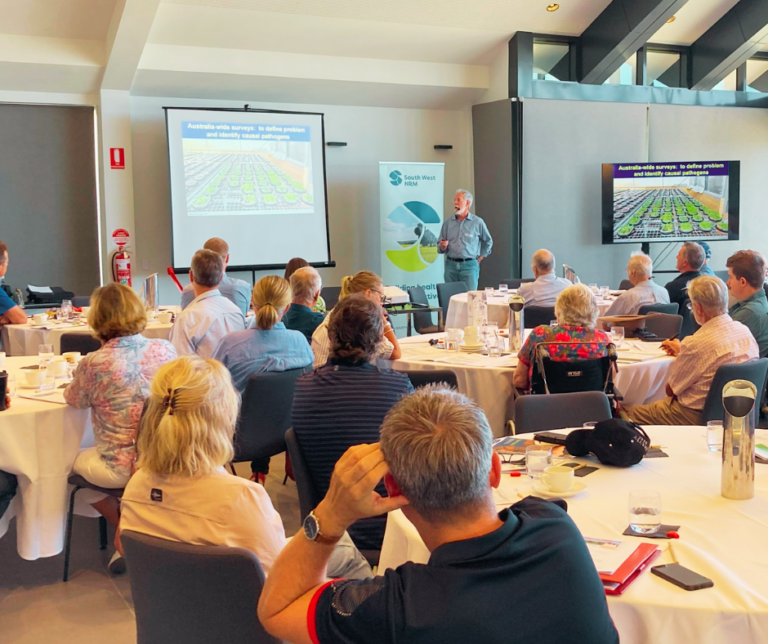
Farmers can improve clover productivity by about 23 per cent if they learn how to effectively manage and reduce root disease, according to UWA Professor Martin Barbetti.
Root diseases in legumes such as clovers and medics reduces root mass and therefore growth and productivity.
And Professor Barbetti said his calculated impact of root disease could even be higher, given he hadn’t included seedlings dying before they emerged from the soil or lower persistence as the clover was outcompeted by weeds.
After 30 years of experience in researching diseases of forage legumes, Professor Barbetti said controlling legume root diseases was a complicated business.
While fungicides could be spectacular under glasshouse conditions, according to Professor Barbetti they didn’t always work in the field. And while phosphonic acid seed treatments could increase productivity, results were erratic and unpredictable.
But understanding root disease with tips on appropriate management actions was key to control so Professor Barbetti shared some of his valuable insights at the February, 2024 concluding event for South West NRM’s Pasture Challenge project.
The Pasture Challenge
Under the Challenge, four groups of farmers were tasked with creating their own agricultural package – a combination of preferred pasture varieties, selected pesticides and fertilisers and then applying any chosen treatments like deep ripping.
Their selected approach should aim to address and overcome problems identified with soil at the Challenge’s Busselton site which included acidity, compaction and clover root disease.
Agricultural packages created by each of the four farmer groups were then applied to three 50m x 3m strips of soil at the test site. One set of three strips also received no treatment at all for a baseline comparison.
The four farmer groups were:
- Rippers – deep ripped and applied 2.5 tonnes of lime per hectare;
- Soil pH – applied 5 tonnes of lime per hectare
- Plant biology – treated compaction with plants and used biological amendments;
- Meat and Tatties – no soil constraint focus.
You can read more about the Pasture Challenge here.
Disease test results captured at the Challenge site were sent to Professor Barbetti for his input about half way through the 12-month project period.
Understanding root disease
Root disease in legumes, such as clovers and medics, shows up as dark lesions on the main tap root, typically resulting in loss of the tap root below the lesion, and dark, stubby lateral roots.
Diseased roots typically have less than adequate nodulation – which was observed in our Pasture Challenge tests! Lower nodulation reduces the fixation of nitrogen from the atmosphere and therefore, also productivity.
Professor Barbetti said in a trial he undertook using the pasture legume medic, he found plots
with root disease were slowly overtaken by weeds such as capeweed, wild radish and erodium. After 5 years the medic was almost absent.
He’s seen the same low persistence caused by root disease in clover.
Traditional methods of control though weren’t always effective he said because there was often a complex of several pathogens (or diseases) present. And depending on the proportions of each disease present – which could vary over time – different conditions would favour different pathogens.
A complex of diseases is what we found during testing at the Pasture Challenge site and provided a great demonstration of this process in action.
Several diseases were present and the Challenge site, including the main culprits – Pythium, Rhizoctonia, Aphanomyces and Phytophthora.
“They are all really damaging pathogens, particularly on sandy soils in South West WA,” Professor Barbetti explained.
“As expected, the Pasture Challenge samples showed that there’s lots of these pathogens, and Phytophthora and Pythium in particular everywhere. We’ve never found a place where Pythium doesn’t occur.
“While Rhizoctonia is very important in the cropping region, it can also be serious in the medium to high rainfall pasture areas.
“Again, it’s pretty much everywhere in the Pasture Challenge, which is what you’d expect. The ‘Biology’ flat treatment is where it was very high. These are very significant levels.
“Aphanomyces was more prevalent on the flat because it’s a water-loving pathogen, another very important pathogen in South West WA. Again it occurred in quite a few plots.
“Phytophthora is probably the most interesting of all the results. It is a huge pathogen problem of pasture legumes across Southern Australia. In many ways it is the number one pathogen of the pathogen complex group.
“Phytophthora is across all plots except two. The two places where we saw really high levels were the ‘Nil’ plots where you had no cultivation or soil disturbance at all.”
Cultivation the key
Professor Barbetti said cultivation had long been known to be very effective in managing root disease.
The level of soil disturbance was directly related to reduction in disease, although other factors such as erosion risk and carbon stocks should also be considered and managed.
“Cultivation can double emergence and root weight and half the level of root disease, doubling the size of plants,” Professor Barbetti said.
“A single cultivation will increase seasonal germination and establishment for a period of 3 to 6 years.”
Grazing management
Grazing management could also make a big difference. If clover severely affected by root disease was grazed too heavily in autumn, it often didn’t recover. So, by avoiding heavy grazing at the beginning of the season and retaining enough leaves on plants to photosynthesize and replenish energy reserves, plants have better ability to generate new roots, significantly improving plant survival and productivity.
Nutrition
Another factor that could help survival was providing sufficient nutrition to ensure the reduced root mass would still be able to take up essential nutrients required to recover and be more resilient to disease.
Our results
Pasture Challenge results tended to support the positive response from cultivation and nutrition. The worst disease tended to be found in Nil and Biology plots, neither of which were cultivated, while other plots were. The Nil also had no nutrition for the year.
Results may also have been affected by different legume varieties used. However, Professor Barbetti pointed out that continual release of resistant legume varieties, while these were productive for initial years, unfortunately has led to rapid development of new races of pathogens. As a result there are now no varieties of clover resistant to the pathogen complex.
Instead of resistance, Professor Barbetti said he now advocates for the development of in field tolerance, resulting in varieties that would be consistently much more resilient to root disease and more productive over a much longer period of many years.
He has found that isolated examples across southern Australia where some ‘old’ clover stands have persisted in paddocks in regions where clovers have been severely affected by root disease and all but disappeared. These tolerant varieties aren’t recognisable commercial varieties. Rather, these are ecotypes that have developed by themselves, and in some cases can provide a 4-5 fold increase in winter clover production. It is these varieties with natural in-field tolerance that offer the best prospects for seed companies to commercialise.
Further research
Severity of phytophthora root rot and pre-emergence damping-off in subterranean clover influenced by moisture, temperature, nutrition, soil type, cultivar and their interactions
https://bsppjournals.onlinelibrary.wiley.com/doi/full/10.1111/ppa.12655
Host resistances to Aphanomyces trifolii root rot of subterranean clover: first opportunity to successfully manage this severe pasture disease
https://bsppjournals.onlinelibrary.wiley.com/doi/full/10.1111/ppa.12475
Manipulating the ecosystem enables management of soilborne pathogen complexes in annual legume forage systems
https://bsppjournals.onlinelibrary.wiley.com/doi/full/10.1111/ppa.12963
Amelioration of root disease of subterranean clover (Trifolium subterraneum) by mineral nutrients
https://library.dpird.wa.gov.au/cgi/viewcontent.cgi?article=1063&context=j_article



